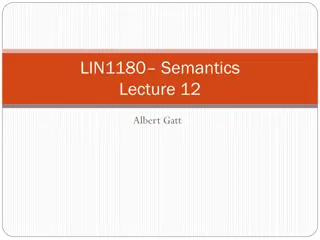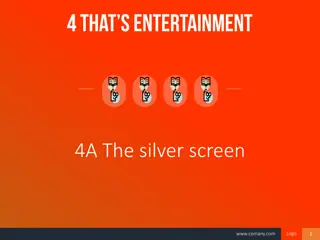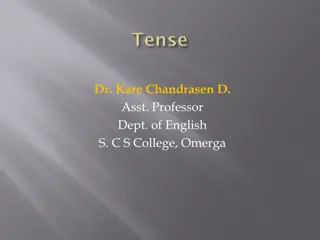Understanding the Present Perfect Tense in English Grammar
The present perfect tense in English grammar is a combination of the present tense and perfect aspect used to express past events with present consequences. It is formed using the auxiliary verb "have" and the past participle of the main verb. This tense is essential for indicating completed actions with relevance to the present moment. Analogous forms exist in other languages like German, French, and Italian. While English also has the present perfect continuous form, the classic present perfect is commonly used for habits, states, and completed actions. The auxiliary verb "have" is always used to form the present perfect in modern English.
Download Presentation

Please find below an Image/Link to download the presentation.
The content on the website is provided AS IS for your information and personal use only. It may not be sold, licensed, or shared on other websites without obtaining consent from the author. Download presentation by click this link. If you encounter any issues during the download, it is possible that the publisher has removed the file from their server.
E N D
Presentation Transcript
TURZM FAKLTES TUR ZM REHBERL TRH115 TEMEL NG L ZCE r. G r. Ya ar G LTEK N
Present Perfect Tense The present perfect is a grammatical combination of the present tense and perfect aspect that is used to express a past event that has present consequences. The term is used particularly in the context of English grammar to refer to forms like "I have finished". The forms are present because they use the present tense of the auxiliary verb have, and perfect because they use that auxiliary in combination with the past participle of the main verb. (Other perfect constructions also exist, such as the past perfect: "I had eaten.").
Present Perfect Tense Analogous forms are found in some other languages, and they may also be described as present perfect; they often have other names such as the German Perfekt, the French pass compos and the Italian passato prossimo. They may also have different ranges of usage: in all three of the languages just mentioned, the forms in question serve as a general past tense, at least for completed actions.
Present Perfect Tense In English, completed actions in many contexts are referred to using the simple past verb form rather than the present perfect. English also has a present perfect continuous (or present perfect progressive) form, which combines present tense with both perfect aspect and continuous (progressive) aspect: "I have been eating". The action is not necessarily complete; and the same is true of certain uses of the basic present perfect when the verb expresses a state or a habitual action: "I have lived here for five years."
Present Perfect Tense In modern English, the auxiliary verb used to form the present perfect is always to have. A typical present perfect clause thus consists of the subject, the auxiliary have/has, and the past participle (third form) of main verb. Examples: I have done so much in my life. You have gone to school. He has already arrived in America. He has had child after child... (The Mask of Anarchy, Percy Shelley) Lovely tales that we have heard or read... (Endymion, John Keats)
Present Perfect Tense Early Modern English used both to have and to be as perfect auxiliaries. The usage differs in that to have expressed emphasis in the process of the action that was completed, whereas to be put the emphasis in the final state after the action is completed. Examples of the second can be found in older texts: Madam, the Lady Valeria is come to visit you. (The Tragedy of Coriolanus, Shakespeare) I am become a name... (Ulysses, Tennyson) I am become Time, destroyer of worlds. (Bhagavad Gita) Pillars are fallen at thy feet... (Marius amid the Ruins of Carthage, Lydia Maria Child) I am come in sorrow. (Lord Jim, Conrad) I am come in my Father's name, and ye receive me not (John 5:43, The Bible)
Present Perfect Tense In many other European languages, the equivalent of to have (e.g. German haben, French avoir, Italian avere) is used to form the present perfect (or their equivalent of the present perfect) for most or all verbs. However, the equivalent of to be (e.g. German sein, French tre, Italian essere) serves as the auxiliary for other verbs in some languages, such as German, Dutch, Danish (but not Swedish or Norwegian), French, and Italian (but not Spanish or Portuguese). Generally, the verbs that take to be as an auxiliary are intransitive verbs denoting motion or change of state (e.g. to arrive, to go, to fall).
Present Perfect Tense The present perfect in English is used chiefly for completed past actions or events when it is understood that it is the present result of the events that is focused upon, rather than the moment of completion. No particular past time frame is specified for the action/event. When a past time frame (a point of time in the past, or period of time which ended in the past) is specified for the event, explicitly or implicitly, the simple past is used rather than the present perfect. The tense may be said to be a sort of mixture of present and past. It always implies a strong connection with the present and is used chiefly in conversations, letters, newspapers and TV and radio reports.
Present Perfect Tense It can also be used for ongoing or habitual situations continuing up to the present time (generally not completed, but the present time may be the moment of completion). That usage describes for how long or since when something has been the case, normally based on time expressions with "for" or "since" (such as for two years, since 1995). Then, the present perfect continuous form is often used, if a continuing action is being described.
Present Perfect Tense The present perfect (traditionally called simply the perfect) combines present tense with perfect aspect, denoting the present state of an action's being completed, that is, that the action took place before the present time. (It is thus often close in meaning to the simple past tense, although the two are not usually interchangeable.) It is formed with the present tense of the auxiliary have (namely have or has) and the past participle of the main verb.
Present Perfect Tense The choice of present perfect or past tense depends on the frame of reference (period or point in time) in which the event is conceived as occurring. If the frame of reference extends to the present time, the present perfect is used. For example: I have written a letter this morning. (if it is still the morning) He has produced ten plays. (if he is still alive and professionally active) They have never traveled abroad. (if they are still alive and considered capable of traveling)
Present Perfect Tense If the frame of reference is a time in the past, or a period that ended in the past, the past tense is used instead. For example: I wrote a letter this morning (it is now afternoon); He produced ten plays (he is now dead or his career is considered over, or a particular past time period is being referred to); They never traveled abroad (similarly). The simple past is generally used when the occurrence has a specific past time frame either explicitly stated (I wrote a book in 1995; the water boiled a minute ago), or implied by the context (for example, in the narration of a sequence of events). It is therefore normally incorrect to write a sentence like I have written a novel yesterday ; the present perfect cannot be used with an expression of past time such as yesterday.
Present Perfect Tense With already or yet, traditional usage calls for the present perfect: Have you eaten yet? Yes, I've already eaten. However, current informal American speech tends to use the simple past: Did you eat yet? Yes, I ate already. Use of the present perfect often draws attention to the present consequences of the past action or event, as opposed to its actual occurrence. The sentence she has come probably means she is here now, while the simple past she came does not. The sentence, Have you been to the fair? suggests that the fair is still going on, while the sentence, Did you go to the fair? could mean that the fair is over
Present Perfect Tense Some more examples: I have eaten. (implies that I'm no longer hungry) We have made the dinner. (implies that the dinner is now ready to eat) The weather has gotten cloudier. (implies that it is now more cloudy than previously) It may also refer to an ongoing state or habitual action, particularly in saying for how long, or since when, something is the case. For example, I have lived in Paris for five years. He has held the record since he won his Olympic gold. We have eaten breakfast together every morning since our honeymoon.
Usage 1: We use this tense when we want to talk about unfinished actions or states or habits that started in the past and continue to the present. Usually we use it to say 'how long' and we need 'since' or 'for'. We often use stative verbs. I've known Karen since 1994. She's lived in London for three years. I've worked here for six months.
Usage 'Since' and 'For We use 'since' with a fixed time in the past (2004, April 23rd, last year). The fixed time can be another action, which is in the past simple (since I was at school, since I arrived). I've known Sam since 1992. I've liked chocolate since I was a child. She's been here since 2pm. We use 'for' with a period of time (2 hours, three years, six months). I've known Julie for ten years. I've been hungry for hours. She's had a cold for a week.
Usage Finished Actions 2: Life experience. These are actions or events that happened sometime during a person's life. We don't say when the experience happened, and the person needs to be alive now. We often use the words 'ever' and 'never' here. I have been to Tokyo. They have visited Paris three times. We have never seen that film.
Usage 3: With an unfinished time word (this month, this week, today). The period of time is still continuing. I haven't seen her this month. She's drunk three cups of coffee today. I've already moved house twice this year! We CAN'T use the present perfect with a finished time word. NOT:I've seen him yesterday.
Usage 4: A finished action with a result in the present (focus on result). We often use the present perfect to talk about something that happened in the recent past, but that is still true or important now. Sometimes we can use the past simple here, especially in US English. I've lost my keys (so I can't get into my house). She's hurt her leg (so she can't play tennis today). They've missed the bus (so they will be late).
Usage 5: We can also use the present perfect to talk about something that happened recently, even if there isn't a clear result in the present. This is common when we want to introduce news and we often use the words 'just / yet / already / recently'. However, the past simple is also correct in these cases, especially in US English. The Queen has given a speech. I've just seen Lucy. The Mayor has announced a new plan for the railways.
Present Perfect Continuous The present perfect continuous (or present perfect progressive) construction combines some of this perfect progressive aspect with present tense. It is formed with the present tense of have (have or has), the past participle of be (been), and the present participle of the main verb and the ending -ing This construction is used for ongoing action in the past that continues right up to the present or has recently finished: I have been writing this paper all morning. Why are his eyes red? He has been crying..
Present Perfect Continuous It is frequently used when stating for how long, or since when, something is the case: She has been working here since 1997. How long have you been sitting there? They have been arguing about it for two weeks. In these sentences the actions are still continuing, but it is the past portion of them that is being considered, and so the perfect aspect is used. (A sentence without perfect aspect, such as I am sitting here for three hours, implies an intention to perform the action for that length of time.)
Usage Unfinished actions 1: To say how long for unfinished actions which started in the past and continue to the present. We often use this with 'for' and 'since' (see the the present perfect simple page for more about 'for' and 'since'). I've been living in London for two years. She's been working here since 2004. We've been waiting for the bus for hours. This use is very similar to how we use the present perfect simple, and often it's possible to use either tense. Of course, with stative verbs, we can't use the present perfect continuous.
Usage 2: For temporary habits or situations. The action started in the past and continues to the present in the same way as with use number 1, but we don't answer the questions about 'how long' so clearly. Instead, we use a word like 'recently'. I've been going to the gym a lot recently. They've been living with his mother while they look for a house. I've been reading a lot recently. This is very similar to the use of the present continuous for temporary habits and often either tense is possible.
Usage Finished actions 3: Actions which have recently stopped (though the whole action can be unfinished) and have a result, which we can often see, hear, or feel, in the present. We don't use a time word here. I'm so tired, I've been studying. I've been running, so I'm really hot. It's been raining so the pavement is wet. The present perfect simple has a very similar use, which focuses on the result of the action, whereas the present perfect continuous focuses on the action itself.
References https://en.wikipedia.org/wiki/Present_perfect https://en.wikipedia.org/wiki/Uses_of_English_verb_forms#Present_perfe ct https://www.perfect-english-grammar.com/present-perfect-continuous- use.html https://www.perfect-english-grammar.com/present-perfect-use.html























